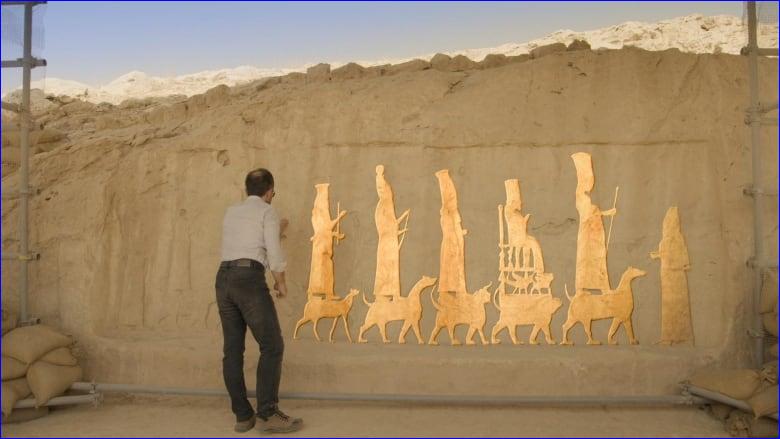


 Lion Television)
Lion Television)
Destruction by ISIS revealed new information
In 2014, Mosul fell under the control of ISIS (also called Daesh). During its three-year reign, the Islamist militants destroyed artifacts and buildings -- mostly shrines that were sacred to other Muslim sects -- saying they were forms of idolatry. But they also targeted sites for looting and to get attention, filming the destruction and sharing it in propaganda videos online.
But ISIS's actions inadvertently created opportunities. Sifting through the wreckage after ISIS's occupation, archaeologists have gained new insights into this great ancient city.
"The Assyrians built the first huge empire in the history of humankind," German professor Stefan Maul said in the documentary. "They excelled at science and engineering, revolutionized warfare, and created one of the world's first great libraries."
"This is the civilization that produced modern knowledge, philosophy, culture and science," Zaid Ghazi Saadallah, director of the Mosul Cultural Museum, said in Arabic.
The Assyrians, and their ancient capital, are shrouded in mystery. How did the empire become so powerful? What engineering marvels transformed Nineveh from a provincial town?
Related: Timeline of ISIS in Iraq
Related: Attacks on Assyrians in Syria By ISIS and Other Muslim Groups
Lost World of the Hanging Gardens shows how archaeological breakthroughs and cutting-edge forensics are helping to solve the riddles of Nineveh -- and giving the people of Mosul hope of reclaiming their city's past.
Artifacts were destroyed with sledgehammers and explosives
ISIS insurgents systematically attacked the Mosul Cultural Museum, proudly showcasing their destruction in online propaganda videos. They destroyed artifacts, which were thousands of years old, with sledgehammers, drills and explosives.
"The hardest day for me was when Daesh showed their video," Saadallah said. "The destruction of civilization."
Today, under his watchful eye, the museum has become an emblem of Mosul fighting back. International teams of restorers are painstakingly repairing and reconstructing the artifacts ISIS sought to destroy -- and ensuring the insurgents don't have the last word.
ISIS built tunnels by hand to loot an underground palace
At Nebi Yunus, a site outside Nineveh, Maul ventures into a labyrinth of tunnels created by ISIS. They built 650 metres of pathways by hand so they could loot an Assyrian palace, which was under a mosque that was believed to house the tomb of the prophet Jonah.
"In 2014, when Daesh conquered Mosul, in their fundamental view of Islamic theology, it is forbidden to pray in front of a grave of a human being," Maul said. "So they simply blew up the mosque."
He believes ISIS found important objects in the palace and sold them on the black market to finance their war. Still, archaeologists have made other discoveries. They've learned more about King Sennacherib, who built the palace, and unearthed clues that are changing our understanding of Assyrian arts and culture.
Discovery of Assyrian technology has led to a novel theory
Beyond Mosul, Kurdish archaeologist Bekas Hasan reveals some of the discoveries that illustrate the ingenuity of the Assyrians.
They constructed an immense water supply -- its network of canals measured about 350 kilometres -- and built the oldest known aqueduct -- a feat of engineering. Made of about two million stone blocks, it predates the earliest Roman example by roughly 400 years and provided Nineveh with a constant supply of water. This allowed the Assyrians to indulge in what might seem like an unlikely passion: gardening.
The discovery of this system has led to a revolutionary theory. British scholar Stephanie Dalley believes Nineveh is the true location of the Hanging Gardens of Babylon.
Sifting through ancient written records and intricate carved reliefs, she found evidence that Sennacherib used the water to nurture a lush, tiered garden in Nineveh. The king's writings, recorded on a clay prism, match ancient descriptions of the Hanging Gardens of Babylon. Archaeologists have never found remains of the gardens, but perhaps they've been looking in the wrong place.
At the time of Sennacherib, the Assyrians ruled the city of Babylon, more than 500 kilometres south of Nineveh. Dalley's research shows that classical and Biblical authors often confused the cities of Nineveh and Babylon. Is it possible the cities were mixed up? Dalley thinks so. A relief from Nineveh shows a lush garden right next to Sennacherib's palace.
An ancient carving is revealed
Lost World of the Hanging Gardens shows the moment archaeologist Aaron Schmitt makes a remarkable discovery -- a carving of the great Assyrian king, and Sennacherib's grandson, Ashurbanipal. It's the first time the artifact has seen the light of day in thousands of years.
"When you excavate for more than 20 years and basically you find only pottery and walls ... But It was not in vain," Schmitt said. "Oh my God, it's so awesome."
Also in Ashurbanipal's palace, archaeologists found one of the crowning achievements of Assyrian culture. The Library of Ashurbanipal is a collection of more than 30,000 tablets, which chronicled all knowledge and included literary epics, scientific theories and Ashurbanipal's laws.
The more archaeologists look, the more they are discovering about Nineveh and the ancient Assyrians. Maul and his team found new evidence of fire and building collapse, which is consistent with how it's believed the city met its demise: it was burned by the Babylonians.
Between 2014 and 2017, ISIS destroyed and looted Assyrian artifacts, but it inadvertently led to discoveries that are shining new light on the empire. Nineveh was an enlightened city that excelled at engineering and the arts -- and might just be the site of the Hanging Gardens of Babylon.

or register to post a comment.